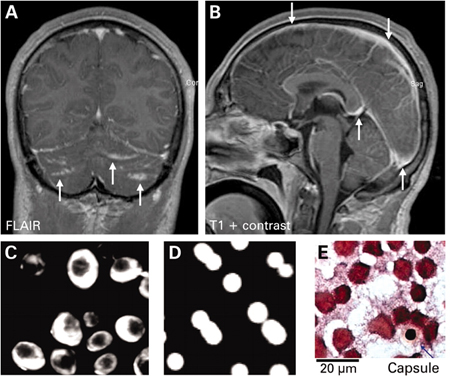Last reviewed: 15 Mar 2025
Last updated: 10 Nov 2022
Summary
Definition
History and exam
Key diagnostic factors
- presence of risk factors
- progressive headache
- severe headache
- meningismus
- symptoms of hydrocephalus (impaired cognitive function, confusion, coordination and gait disturbances, and urinary incontinence)
- behavioural or personality change
- reduced visual acuity and papilloedema
Other diagnostic factors
- nausea or vomiting
- fever
- reduced conscious level
- cranial nerve palsies
- seizures
- weight loss
- mouth ulcers
- focal neurological signs
- lymphadenopathy, hepatosplenomegaly
- dyspnoea
- papular umbilicated skin lesions
- retinal defects
- nasal or palatal eschar
Risk factors
- HIV infection
- corticosteroid use
- underlying chronic disease (e.g., malignancy, organ failure, autoimmune disease, organ transplant)
- residing in or visiting northern Australia, Papua New Guinea, or Vancouver Island, Canada
- exposure to disturbed soil, chicken guano, or bat caves
- impaired cell-mediated immunity
- Filipinos and African Americans
- neutropenia or impaired phagocytic function
- neurosurgery
- infants and neonates
- central vascular catheters
- sinonasal disease
- antibacterial usage
- prior surgery
- hyperalimentation
- intravenous drug use
Diagnostic investigations
1st investigations to order
- CT and/or MRI head scan
- fungal blood cultures (3 sets)
- serum cryptococcal antigen test
- serum + urine Histoplasma antigen
- immunodiffusion tests (IgM and IgG) and complement fixation test (IgG) for coccidioidomycosis
- cerebrospinal fluid opening pressure
- cerebrospinal fluid (CSF) WBC and differential
- cerebrospinal fluid (CSF) protein
- cerebrospinal fluid (CSF) glucose
- cerebrospinal fluid India ink stain
- cerebrospinal fluid (CSF) culture
- cerebrospinal fluid cryptococcal polysaccharide antigen test
- cerebrospinal fluid Histoplasma antigen
- cerebrospinal fluid Histoplasma antibodies
- cerebrospinal fluid coccidioidal IgG antibodies
- cerebrospinal fluid (CSF) galactomannan antigen test
Investigations to consider
- histopathology and culture of biopsies: meningeal, brain, extraneural sites of involvement
- polymerase chain reaction (PCR)
Emerging tests
- 18F-fluorodeoxyglucose (FDG) PET/CT
- cerebrospinal fluid (CSF) (1-3)-beta-D-glucan
Treatment algorithm
Contributors
Authors
Abhijit Chaudhuri, DM, MD, PhD, FACP, FRCP (Glasg), FRCP (Lond)
Consultant Neurologist
Clinical Lead of Neuroinflammation
Department of Neurology
Queen's Hospital
Romford
UK
Disclosures
AC declares that he has no competing interests.
Acknowledgements
Dr Abhijit Chaudhuri would like to gratefully acknowledge Dr Thomas S. Harrison and Dr Angela Loyse, previous contributors to this topic.
Disclosures
TSH and AL declare that they have no competing interests.
Peer reviewers
Robert A. Larsen, MD
Associate Professor of Medicine
University of Southern California
Keck School of Medicine
Los Angeles
CA
Disclosures
RAL declares that he has no competing interests.
Use of this content is subject to our disclaimer
